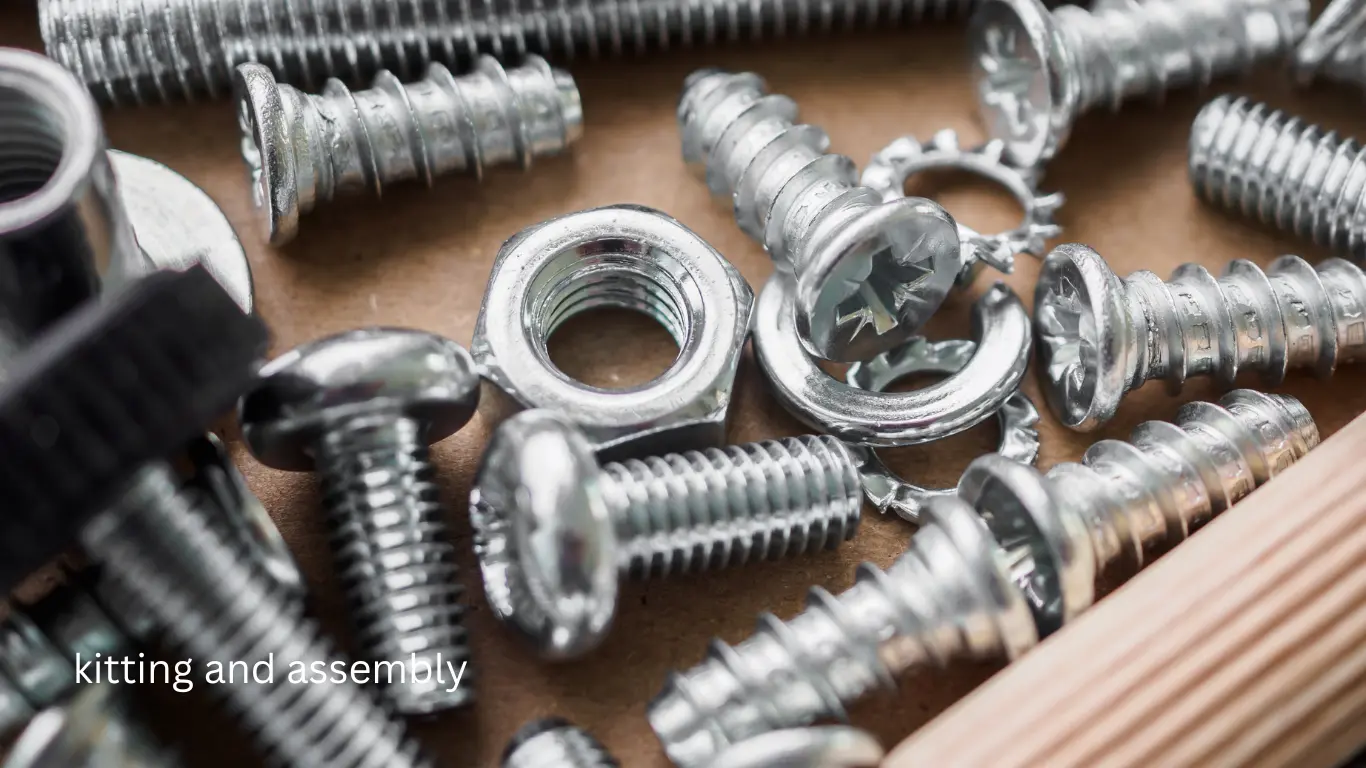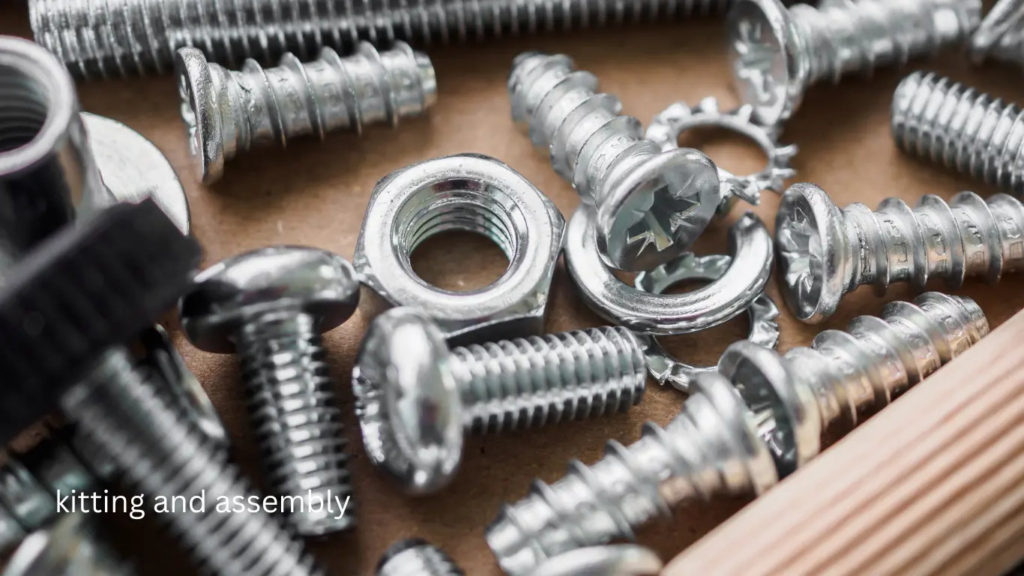Packaging and selling a single product at a time takes a lot of time. With kitting and assembly in inventory, personnel can take similar items and combine them to make a value-added kit.
It involves gathering individual components or parts and combining them into ready-to-use kits or assembled products. In kitting, parts are grouped, packaged and labelled for easy access during assembly or shipping. In modern manufacturing operations, kitting and assembly play a crucial role in streamlining production and improving efficiency. By gathering all required components into a single kit before final assembly, manufacturers minimize downtime and ensure smooth workflow transitions. This integrated approach accelerates production cycles while maintaining product quality.
Assembly is the process of putting these parts together to form a complete product. This process streamlines production, reduces errors, and improves efficiency, particularly in manufacturing and supply chain operations.

Defining Kitting and Assembly
When you group related products in inventory management that is known as kitting. The products are grouped in a single kit or package. Then the kit gets a unique SKU and is shipped off. A well-planned kitting assembly process ensures that each product build begins with all necessary parts in place. This not only reduces assembly errors but also enhances traceability and coordination between the warehouse and production floor. It’s a strategic way to minimize waste and boost overall productivity.
On the other hand, the latter component of kitting and assembly” refers to the process in manufacturing where you put individual parts together. You do so to make a complete product. This ensures that each component fits with the other and works properly. Outsourcing assembly and kitting services can deliver measurable gains in speed, accuracy, and operational scalability. Partnering with professionals who understand component management ensures seamless product flow and reduces overhead costs, making it an efficient solution for modern manufacturers.
With that let’s see the types of kitting and assembly and what it means for the inventory management process.
Kitting and Assembly Types
These two processes play a crucial role in streamlining production processes, optimising inventory management, and enhancing overall operational efficiency. Let’s see how these tailored solutions of kitting and assembly work to meet specific manufacturing needs driving business.
3 Types of Kitting in Manufacturing
Here are the types:
Order Fulfilment Kitting
This process in order fulfilment means that you have to pack similar individual items together so you can ship them in a single kit. These items must have their SKU. For instance, an auto parts warehouse can combine everything they need for replacing brakes in a kit.
Or, when you want to assemble a furniture piece, you can take a “assemble it yourself kit” that comes with all the screws, and other parts you need to make the furniture price. Kits are usually preassembled, so manufacturers and retailers can ship them as soon as they receive the order.
Kitting in a Warehouse
This process oversees the gathering of all important materials together to make up a particular product. Then they deliver it to the production floor so manufacturers can assemble them into a single piece.
This process requires parts to be put in a specific order from station to station as the parts go through the production process. This could mean gathering all the parts to manufacture an automobile or an appliance. This ensures that the assembly line functions smoothly without any interruption.
Private Label Kitting
This form of kitting happens when a group of products comes from different providers. You gather and then ship them a single package from a different company. Maybe the best example of private label kitting can be the Amzpin fulfilment centres that we see.
These warehouses have individual products from different ecommerce sites. So the team can collect them as the customer orders come in. This makes it easy for the company to efficiently fulfil; orders for items like earbuds, pants or coffee makers.
Now that we have seen the kitting types let’s see the types of the latter phenomenon in the “kitting and assembly” process.
2 Types of Assembly Process
Manual Assembly
Manual assembly sees workers using hand tools to put together parts. Some examples could include assembling small electronic devices or furniture:
Pros and Cons:
- Pros: It’s flexible for handling complex and varied tasks. Can easily adapt to changes.
- Cons: Prone to human error and slower, also has higher labour costs.
Automated Assembly
Automated assembly relies on machines and robots to perform repetitive tasks—for instance, manufacturing and electronics production.
Pros and Cons:
- Pros: Faster production speeds with consistent quality lowering long-term costs.
- Cons: High initial investment that requires special maintenance.
Choose the right assembly process per your production needs, budget and efficiency level required for your business.
Now that you know about kitting and assembly in detail let’s see how they compare.
| Aspect | Kitting Process | Assembly Process |
| Purpose | Organizes and packages all required components into kits | Combines components or kits to create the final product |
| Focus | Preparation and organization of parts | Physical construction and integration of parts |
| Efficiency | Speeds up assembly by reducing search time and errors | Directly impacts product quality and functionality |
| Example | A furniture kit containing screws, bolts, and tools | Assembling the furniture using the provided kit |
| End Result | A complete kit with all needed parts | A fully constructed product ready for use |
5 Benefits of Inventory Kitting
The sole purpose of kitting is to make the lives of manufacturers and retailers easier and more streamlined. If you are a person who likes to prepare all the plans, and clothes for tomorrow beforehand, you will appreciate the kitting benefits.
Ensures More Efficient Operation
When all the components needed to build a product or complete a bundle are readily available, you minimize downtime spent searching for them. Think about the frustration of realizing you’re out of flour halfway through baking a cake. Now, contrast that with the simplicity of using a pre-packaged cake mix.
Reduce Errors with Kitting
You will hardly get things wrong when all the elements of one product are lined up, and ready to be assembled. With kitting, you also get better quality control. When you have everything pre-kitted, fewer variables lead to error and inconsistent quality.
Easy Inventory Management
Kitting helps you to turn all SKUs into one- this accelerates the picking process. Also, it’s easier to quickly count the kit numbers to tally all the parts that you need to manufacture the product.
Higher Productivity
When you have everything near you, productivity will be higher. Production processes are faster and more efficient when you waste less time gathering parts. This allows you to get more work done in a single day.
Reduces Production Costs
The manufacturing cost of the product depends on the kind of labour that goes into it. When you have assemblies or sub-assemblies readily available, the time you save is directly converted into cost savings which allows your profit to grow.
Now finally it’s time for the kitting process in the chain of kitting and assembly.
Kitting Process
Here are the steps for this process:
- Decide What the Contents of the Kit Will Be: This decision depends on various factors, such as grouping frequently bought items, highlighting new products, or promoting older stock that needs to sell.
- Decide Who Assembles the Kit: Companies have the option to either assemble the kit in-house or outsource the basic manufacturing process to a kitting contractor who will handle shipping and labelling.
- Assign a new SKU: Creating a new product number for the kit enables tracking of sales and inventory.
- Organise the Items: To enhance picking efficiency, companies can preassemble kits or place kit components close together in the warehouse.
- Time for Shipping: Consolidate and dispatch the items as a single package.
Companies can manage the manufacturing and assembly of kits internally or outsource these tasks to a contractor who will also handle shipping and labelling. Many companies now rely on specialized kitting and assembly services providers to handle complex product configurations. These expert partners ensure precision, consistency, and timely delivery by managing the entire process — from component organization to final packaging — enabling manufacturers to focus on core operations
Conclusion
Kitting and assembly processes play vital roles in enhancing manufacturing efficiency. Kitting streamlines inventory management by grouping components into ready-to-use kits, reducing downtime and errors.
Assembly, whether manual or automated, focuses on constructing the final product from these kits, ensuring quality and functionality. Together, these processes optimize production, improve accuracy, and drive cost savings, making them essential for effective supply chain operations. Visit Qodenext for more efficient supply chain solutions.
FAQs: Kitting and Assembly in Manufacturing: Unveiling the Benefits and Best Practices
1. What is the meaning of lean manufacturing?
This type of manufacturing aims to minimise waste and maximise productivity. It improves processes to ensure value for customers. It eliminates processes that add no value, creating waste.
2. What are the two types of assembly?
They are- private and shared. You can use the private assembly for a single application. On the other hand, a shared assembly is for use for all kinds of applications.
3. What is the role of a kitting specialist?
A kitting specialist organises, assembles, and prepares kits by grouping components, ensuring accuracy and efficiency for streamlined production and distribution processes.
4. What are the key aspects of an assembly line?
They include workflow efficiency, task specialization, standardized procedures, sequential operations, and equipment integration to streamline production.
5. What is the difference between kitting and assembly in manufacturing?
Kitting involves grouping related components together into organized kits for easier assembly, while assembly refers to physically putting those components together into a finished product.
6. How does kitting improve manufacturing efficiency?
It reduces time spent searching for components, minimizes errors, optimizes space, and streamlines workflow on the assembly floor.
7. What industries benefit most from kitting and assembly?
Automotive, electronics, medical devices, furniture, and e-commerce fulfillment companies use kitting and assembly to accelerate production and maintain consistent quality.
8. What are the main types of kitting used in manufacturing?
Common types include order fulfillment kitting, warehouse kitting, and private label kitting — each serving different supply chain and production needs.
9. How does automation enhance kitting and assembly processes?
Automation uses robotics, AI, and machine learning to improve kit accuracy, reduce human error, and speed up assembly operations.
10. Can small manufacturers benefit from kitting?
Yes, even small manufacturers can use kitting to reduce labor costs, improve inventory control, and scale operations efficiently.







